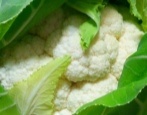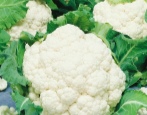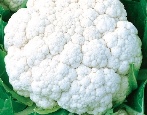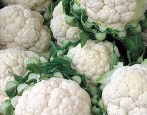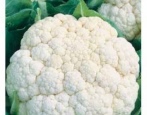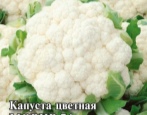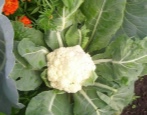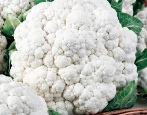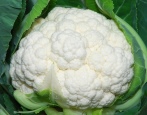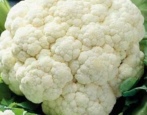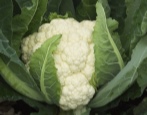
- Name synonyms: Bruce
- Year of approval: 2008
- Appointment: for home cooking, for fresh consumption
- Leaf rosette: raised
- Sheet length: middle length
- Leaf color: gray-green, with a waxy bloom of medium intensity
- Sheet surface: slightly bubbly
- Edge of the sheet: wavy
- Yield: high
- Average yield: 4.5 kg / sq.m
Bruce cauliflower (Bruce) is a popular hybrid of Dutch breeding, since 2008 officially presented on the Russian market. It is distinguished by excellent taste, large size of inflorescences, versatility of use. The hybrid is unpretentious, well protected from the main diseases of the culture, time-tested in planting in different regions of the Russian Federation.
Description of the variety
The hybrid is grown in an annual culture. Suitable for planting in open ground, as well as for cultivation under film shelters. It is considered very early maturing, stress-resistant, versatile. Needs light shading during the ripening stage to avoid discoloration of the heads.
Characterization of the appearance of the plant and heads
Plants form a raised leaf rosette with plates of medium length. The shade of the shoots is gray-green, there is a weak waxy bloom. Leaves of the same color, elliptical, slightly bubbly, with a wavy edge.
The head of the cauliflower is round-flat, medium-sized, weighing about 1.5 kg. The shade of the inflorescences is white. The surface is medium-tuberous, the heads themselves are leveled, dense, covered with leaves.
Purpose and taste
Inflorescences are widely used in cooking. They are boiled, mashed for baby and diet food, fried and baked. Fresh vegetable is suitable for adding to smoothies. The inflorescences have good palatability, with pleasant, delicate notes, light crunch, and pleasant texture.
Ripening terms
Bruce is a mid-season hybrid. From the moment of emergence to harvest, 85-100 days pass.
Yield
A hybrid with high yields. Average collection rates are 4.5 kg / m2.
Growing regions
Plants are planted in many regions. The hybrid is adapted to the climate of the north and northwest, successfully cultivated in the Urals and Siberia. In the Central Black Earth Region and in the North Caucasus, planting in open ground is practiced without first distilling seedlings. The optimal planting pattern on a ridge is 30 × 50 cm.
Growing and care
Bruce cauliflower needs planting in sunny areas. With the seedling method of cultivation, the seeds are sown in April. Plants are transferred to open ground in May. It is advisable to immediately sow the plants in individual containers so as not to damage the sensitive root system with a dive. Before being sent to the ground, the plants are hardened for 10-20 days.
To prevent shooting, Bruce's cauliflower is in no hurry to move to a permanent place without shelter. It is important that the air temperature does not fall below + 18 ... 20 degrees.
The hybrid is as unpretentious as possible, does not require special feeding, frequent fertilization. But he needs regular watering at intervals of 3-4 days. It is necessary to bring under the bush no more than 2-4 liters of warm settled water. After 3 weeks in the open field, the schedule is changed. Plants are moistened every 7 days, increasing the volume of water by 2 times.
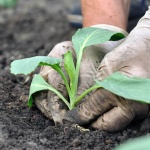
Soil requirements
Almost any type of soil is suitable in composition, but always light, permeable to air and water. The laying of mineral fertilizers is not necessary, but reclamation will benefit the future harvest.
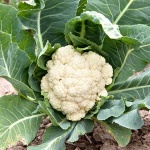
Required climatic conditions
The Bruce hybrid is frost resistant. Well adapted to changes in atmospheric temperatures in the spring, to a cold snap at the end of summer. Forms inflorescences successfully even with the minimum number of sunny days.
Disease and pest resistance
The plant's immunity is quite high. But it does not protect against attacks of insect pests. Cruciferous fleas appear on the plants, which can be fought with natural remedies, tobacco dust or wood ash. Also, Bruce cauliflower can be damaged by caterpillars of whitefly butterflies or aphids. Preventive spraying against these pests is carried out at intervals of 10 days.
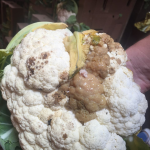
Review overview
Dutch cauliflower Bruce was appreciated by many summer residents. Praised for its excellent covering ability, the heads are well protected from external leaf threats during the ripening process. Plants easily tolerate even frosts, bear fruit perfectly in cold climates and cloudy weather. The culture is also not too sensitive to dampness, but it is better to avoid overflows so as not to provoke the development of fungal diseases.
Almost all summer residents mention the excellent taste of cauliflower heads, as well as the large size of the inflorescences. The pure, creamy white color remains even during boiling and other processing. Summer residents note that you can start collecting them a little earlier than the stated date, 2 months after the emergence of shoots.
There are practically no negative reviews. The only thing that vegetable growers are unhappy with is the need to regularly purchase seeds. You cannot propagate a hybrid on your own.
